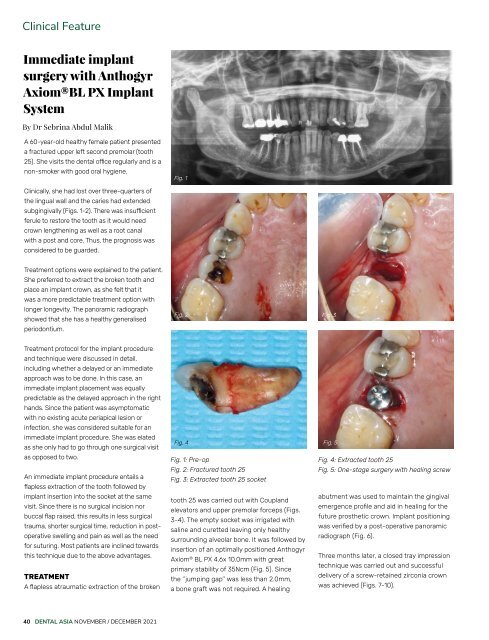Dental Asia November/December 2021
For more than two decades, Dental Asia is the premium journal in linking dental innovators and manufacturers to its rightful audience. We devote ourselves in showcasing the latest dental technology and share evidence-based clinical philosophies to serve as an educational platform to dental professionals. Our combined portfolio of print and digital media also allows us to reach a wider market and secure our position as the leading dental media in the Asia Pacific region while facilitating global interactions among our readers.
For more than two decades, Dental Asia is the premium journal in linking dental innovators
and manufacturers to its rightful audience. We devote ourselves in showcasing the latest dental technology and share evidence-based clinical philosophies to serve as an educational platform to dental professionals. Our combined portfolio of print and digital media also allows us to reach a wider market and secure our position as the leading dental media in the Asia Pacific region while facilitating global interactions among our readers.
You also want an ePaper? Increase the reach of your titles
YUMPU automatically turns print PDFs into web optimized ePapers that Google loves.
Clinical Feature<br />
Immediate implant<br />
surgery with Anthogyr<br />
Axiom®BL PX Implant<br />
System<br />
By Dr Sebrina Abdul Malik<br />
A 60-year-old healthy female patient presented<br />
a fractured upper left second premolar (tooth<br />
25). She visits the dental office regularly and is a<br />
non-smoker with good oral hygiene.<br />
Fig. 1<br />
Clinically, she had lost over three-quarters of<br />
the lingual wall and the caries had extended<br />
subgingivally (Figs. 1-2). There was insufficient<br />
ferule to restore the tooth as it would need<br />
crown lengthening as well as a root canal<br />
with a post and core. Thus, the prognosis was<br />
considered to be guarded.<br />
Treatment options were explained to the patient.<br />
She preferred to extract the broken tooth and<br />
place an implant crown, as she felt that it<br />
was a more predictable treatment option with<br />
longer longevity. The panoramic radiograph<br />
showed that she has a healthy generalised<br />
periodontium.<br />
Fig. 2 Fig. 3<br />
Treatment protocol for the implant procedure<br />
and technique were discussed in detail,<br />
including whether a delayed or an immediate<br />
approach was to be done. In this case, an<br />
immediate implant placement was equally<br />
predictable as the delayed approach in the right<br />
hands. Since the patient was asymptomatic<br />
with no existing acute periapical lesion or<br />
infection, she was considered suitable for an<br />
immediate implant procedure. She was elated<br />
as she only had to go through one surgical visit<br />
as opposed to two.<br />
An immediate implant procedure entails a<br />
flapless extraction of the tooth followed by<br />
implant insertion into the socket at the same<br />
visit. Since there is no surgical incision nor<br />
buccal flap raised, this results in less surgical<br />
trauma, shorter surgical time, reduction in postoperative<br />
swelling and pain as well as the need<br />
for suturing. Most patients are inclined towards<br />
this technique due to the above advantages.<br />
TREATMENT<br />
A flapless atraumatic extraction of the broken<br />
Fig. 4 Fig. 5<br />
Fig. 1: Pre-op<br />
Fig. 4: Extracted tooth 25<br />
Fig. 2: Fractured tooth 25<br />
Fig. 5: One-stage surgery with healing screw<br />
Fig. 3: Extracted tooth 25 socket<br />
abutment was used to maintain the gingival<br />
tooth 25 was carried out with Coupland<br />
emergence profile and aid in healing for the<br />
elevators and upper premolar forceps (Figs.<br />
future prosthetic crown. Implant positioning<br />
3-4). The empty socket was irrigated with<br />
was verified by a post-operative panoramic<br />
saline and curetted leaving only healthy<br />
radiograph (Fig. 6).<br />
surrounding alveolar bone. It was followed by<br />
insertion of an optimally positioned Anthogyr<br />
Three months later, a closed tray impression<br />
Axiom ® BL PX 4.6x 10.0mm with great<br />
technique was carried out and successful<br />
primary stability of 35Ncm (Fig. 5). Since<br />
delivery of a screw-retained zirconia crown<br />
the ‘’jumping gap’’ was less than 2.0mm,<br />
was achieved (Figs. 7-10).<br />
a bone graft was not required. A healing<br />
40<br />
DENTAL ASIA NOVEMBER / DECEMBER <strong>2021</strong>


















